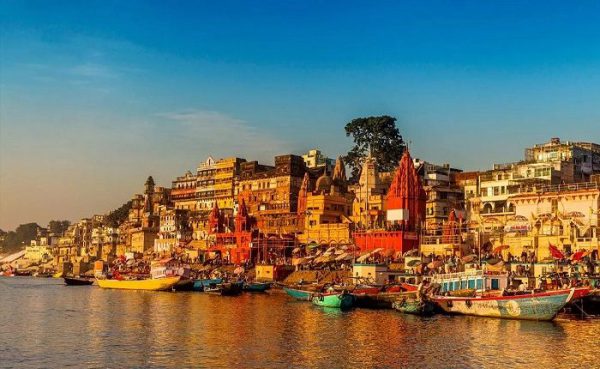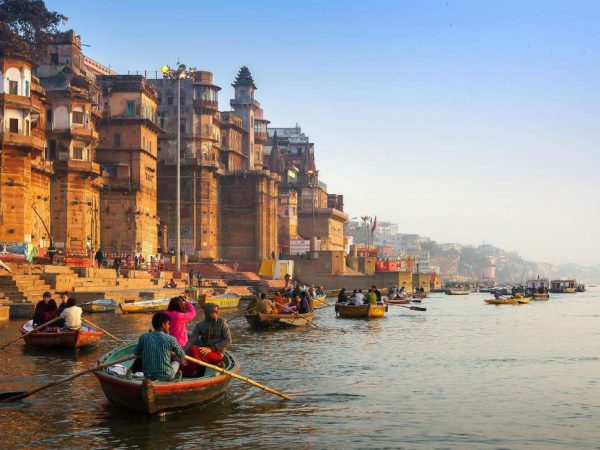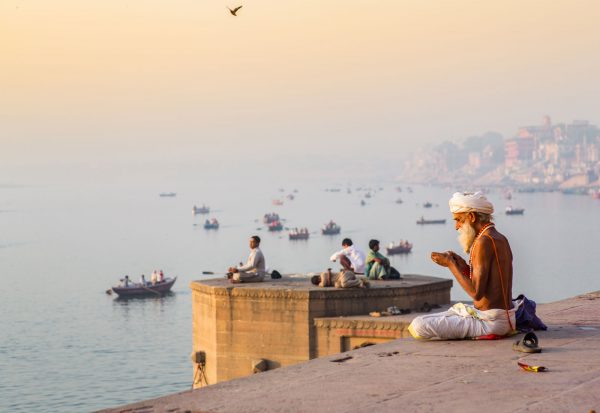KOLKATA, India, 14 April: Our Armchair travel series looks at a popular Pandaw Cruise sailing to Varanasi, India’s spiritual capital.
For the present, we stay at home to beat the Covid-19 pandemic, but this a river journey should be high up the must-do list once the crisis is over.

Varanasi, India’s foremost religious destination that also goes by Benaras, Banaras or Kashi, stands on the banks of the river Ganges, held most sacred by Hindus, and embodied by the goddess Ganga. Legend has it that Lord Shiva released the river from a knot of his hair.
Hindus believe that the waters of the river Ganga wash away mortal sins and liberate the soul from the cycle of life and death. Over 2.5 million visitors arrive at Varanasi to take a dip in the holy waters, today quite polluted, or to scatter the ashes of their cremated loved one to free them from the cycle of reincarnation.
Foreign tourists to Varanasi typically have no intention of stepping into the already pretty crowded waters of the Ganges, rather, prefer experiencing the glorious sunrise and Hindu way of life on an early morning boat ride, or schedule an evening boat ride to feel one with the famous fire ritual or aarti performed at dusk every day.
Here’s why: although the river’s tributaries are cool springs fed by Himalayan glaciers, at their meeting point in the country’s intensely populated cities, and eventual emptying into the Bay of Bengal, the pure waters become a toxic waste of trash and sewage. There is no denying the fact that dipping into the Ganges means exposing yourself to polluted waters done a grave injustice by human activities, including the dumping of industrial waste, tossing of ashes, washing of clothes and bathing by humans.
The Athens of India
It is archaeologically proven that Varanasi has been continuously inhabited for 2,500 years. Pottery dating to 1000 B.C. and broken masonry from A.D. 1500 were discovered by archaeologists in the ruins of Old Varanasi. Varanasi is regarded as one of the world’s oldest continuously inhabited cities, among the very few settlements that have continued on to this day.
In Hinduism and Jainism, Varanasi is considered as one of the seven holiest cities, together known as Sapta (seven) Puri (town/city). Varanasi also has a special place in Buddhism. At nearby Sarnath, the Buddha is believed to have founded Buddhism, the fourth largest religion in the world, in 528 BCE. This is the place where he delivered his first teaching “The Setting in Motion of the Wheel of Dharma”, after attaining enlightenment.
Varanasi’s religious importance received an impetus in the 8th century when Indian philosopher and theologian Adi Shankara – who is credited for consolidating and establishing the Advaita Vedanta philosophy of self-existent awareness and non-duality – established Lord Shiva as an official deity of Varanasi.
The city’s status as a Hindu pilgrimage site did not suffer under Muslim rule. Mughal emperor Akbar built two large temples dedicated to gods Shiva and Vishnu here. In 1737, the Mughals accorded the Kingdom of Benaras official status and continued their dynastic rule until Indian achieved independence in 1947. However, the credit for developing much of modern Varanasi goes to the Brahmin and Maratha kings.
It is in Varanasi that renowned Hindu poet and saint Tulsidas wrote his epic poem Ram Charit Manas, one of the greatest works of Hindi literature. Varanasi is also the birthplace of Kabir and Ravidas, prominent figures of the Bhakti movement, a revolution set forth by Hindu saints to bring about religious reform, and resulted in various rituals of devotion practised by the Hindus, Muslims and Sikhs. The saints preached in the local language to reach the masses, particularly the disempowered lowest rungs of the Indian society and were vocal in their opposition to the caste system. In 1507, Guru Nanak, founder of Sikhism, visited Varanasi on a trip that proved highly influential in the founding of Sikhism, the world’s ninth-largest religion.
Lying along National Highway 2, the city is served by the Lal Bahadur Shastri International Airport and Varanasi Junction railway. Its governing body is the Varanasi Nagar Nigam, and since 2014, it is represented in the Indian Parliament by current Prime Minister Narendra Modi.
Varanasi is world-famous for its handloom-woven embroidered textiles. Apart from tourism, the city has thriving silk weaving and crafts industries. It is also home to Bharat Heavy Electricals Limited (BHEL), a government of India owned engineering and manufacturing company, Tata Consultancy Services, and one of 23 Indian Institutes of Technology (IIT), autonomous higher education institutes of national importance.
Of Temples and Ghats
An estimated 23,000 temples dot Varanasi’s landscape, with most located at walking distance from one another. The most important one is perhaps the Kashi Vishwanath Temple featuring a 50 feet gold plated spire, and enshrining one of the twelve Jyotirlingams or devotional representations of Lord Shiva. Over a million devotees flock the temple on some days.
Varanasi has 88 ghats, which are stairs leading down to the river Ganges, a majority of which are reserved for bathing and puja ceremonies while two serve as cremation sites.
The ghats have their own unique character and mythology. The most famous is the Dashashwamedh Ghat that Lord Brahma, the creator god in Hinduism, is believed to have created to welcome Lord Shiva. The ghat attracts a constant flow of pilgrims and priests from dawn to dusk, and you’re greeted by frantic scenes of flower-sellers peddling their wares and beggars entreating people for alms.
You won’t find people bathing on Narad ghat as it is believed that bathing with the spouse here causes fights! Darbhanga ghat is home to the Brijrama Palace hotel, previously the 19th-century Brijrama Palace embodying Indian and Greek architectural styles. It was originally a fort built in 1812 by Sridhar Narayan Munshi of the Royal House of Nagpur, and acquired by 1915 by King Rameshwar Singh Bahadur of Darbhanga, now comprising the northern part of the Indian state of Bihar.
The Spectacular Aarti
One of Varanasi’s biggest draws is the evening aarti, performed at 1900 every evening during summers and at 1800 during the winter months. The uplifting audio-visual spectacle attracts the faithful and the faithless. The aarti comprises a precise choreography where priests worship the Ganges using large flaming brass lamps which they circle around in a clockwise direction, to the accompaniment of Sanskrit mantras, songs, bells, drums and cymbals.
Sarnath
The Pandaw river cruise itinerary of the Upper Ganges includes a visit to Sarnath, a small village located a few miles north-east of Varanasi. It is famous for its deer park, where the Buddha is believed to have delivered his first discourse. Sarnath is one of four main Buddhist pilgrimage sites, others being Lumbini in Nepal, Bodh Gaya in Bihar, and Kusinagara in Uttar Pradesh.
Sarnath derives from the Sanskrit word ‘Saranganatha’, which means ‘lord of the deer’; according to Buddhist legend, a deer by the name of Bodhisattva offered his life in exchange for the doe a king was about to kill, moving the king so much that he constructed the park as a sanctuary for deer.
Tranquil and green, Sarnath is an ideal stop en route to Varanasi.
This heritage tour will stay with you for a long time – after all, you will be returning from one of the world’s oldest surviving cities! As author Mark Twain, who visited Benaras in 1896 said of the city:
“Benares is older than history, older than tradition, older even than legend, and looks twice as old as all of them put together.”
Pandaw Cruises
- The Upper Ganges River
- Kolkata – Varanasi
- 10% discount and no single supplement on selected dates.
- 14 nights from USD5,524.20
- Members from USD4,910.40
- Source: Pandaw Cruises travel blog
For the full-text see:
https://www.pandaw.com/blog/cruise/varanasi-indias-spiritual-capital










Hi, Great Post, Thanks for sharing,
Regards,
BiharJobAlert.com